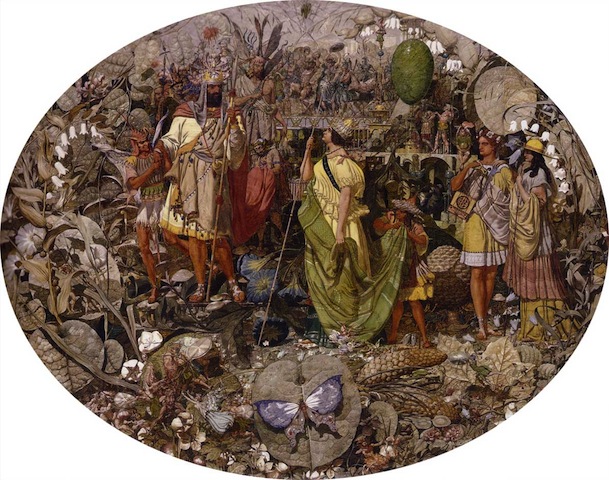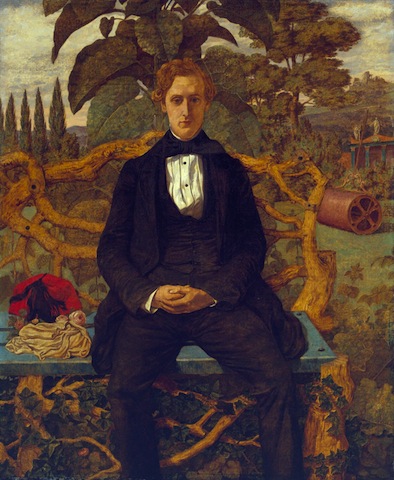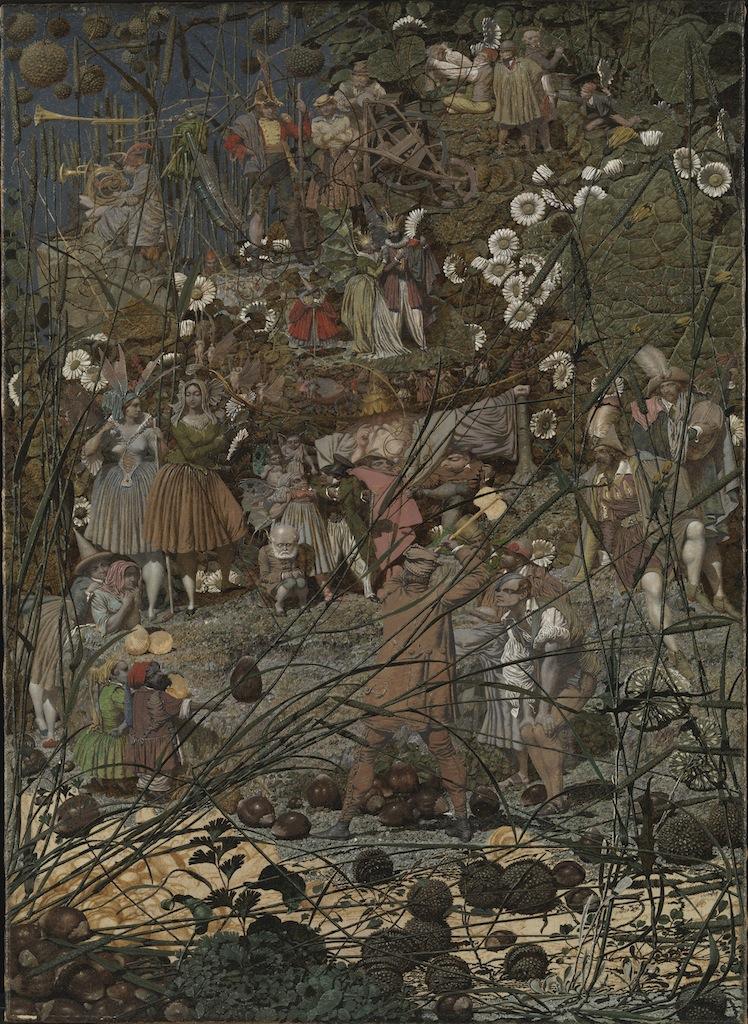The Watts Gallery in rural Surrey is a very genteel setting for a show by a figure who for most of his life was denied polite society. Richard Dadd spent 42 years in mental hospitals, first at Bethlem, then Broadmoor. As one can infer, he was criminally insane, and despite a disarming interest in fairies, his life and work cannot be spun into a happy-ever-after narrative.
It's the fairies not the diagnosis that won him acclaim, inspiring his two greatest works: The Fairy Feller’s Master-Stroke, 1855-64 (main picture) and Contradiction. Oberon and Titania,1854-58 (pictured below) are both in this exhibition and offer mythical scenes which conflate Shakespeare with the creative universe of Dadd himself. The artist wrote his own 24-page poem to accompany the first; the second owes its drama to A Midsummer’s Night Dream.
As you can imagine, we are here a long way from Disney’s Tinker Bell. Dadd’s cast emerge from the undergrowth in multitudes: troll-like, satyr-like, centaur-like, but more often than not in perfect, if tiny, human form. Most of their faces are wan grey, as if in imitation of early photographs. And the viewer has to peer through blades of grass and past dock leaves to take in the processional action; the artist is such a fine miniaturist that to-scale daisies and snowdrops have larger heads than his figures.
 The fairy feller’s “master-stroke” had its catastrophic real-world counterpart; in the grip of psychosis in 1843, Dadd felled his father with a knife. Then in one of the most upsetting artist quotes ever, he cried to the star-filled heavens: “Go and tell the great god Osiris that I have done the deed which is to set him free”. (Osiris showed his new servant few favours, because after trying to kill a fellow coach passenger, Dadd was arrested in France.)
The fairy feller’s “master-stroke” had its catastrophic real-world counterpart; in the grip of psychosis in 1843, Dadd felled his father with a knife. Then in one of the most upsetting artist quotes ever, he cried to the star-filled heavens: “Go and tell the great god Osiris that I have done the deed which is to set him free”. (Osiris showed his new servant few favours, because after trying to kill a fellow coach passenger, Dadd was arrested in France.)
Biographical readings may at times be lazy criticism. But the alternative, to write up this show with no reference to the artist’s crime, state of mind or studio arrangements, would require suspension of reality to an equally mad degree. In room one is the ledger from Bethlem, larger than most of his paintings, in which we can read Dadd’s name and occupation for ourselves. There is also a photo of the artist at work on Contradiction; his pale eyes look dangerous. His case notes are reproduced on the wall and mention a portfolio of portraits in which all his friends appear with their throats cut.
So it is very difficult to evaluate Dadd without the medical tourism. His work “haunts”; it “disturbs”; it is “possessed”. Nineteenth-century madness appears wilder and more frightening than its 21st century equivalent, with our care in the community and our second generation drugs. Had the artist recovered, this might have become a tragedy we could nicely assimilate. But as it is, his life and work remain totally uncanny.
But Dadd himself might have been happy. He encountered humane doctors. And a 20-year spell in Broadmoor offered him picturesque surroundings, plenty to read, and the company of educated fellow patients. His art was encouraged and, thanks to hospital sponsorship, he was never short of the best materials. Painting was an inalienable talent and it ran deeper than his mental afflictions.
 Indeed, he appears to suspend those altogether in order to paint Portrait of a Young Man in 1853 (pictured right; Tate). This shows his doctor, and collector, William Charles Hood, exhibiting calm, poise and good humour – all those qualities that psychotic, nervous or depressive illness can put beyond reach. The only concession to madness here is the fantastical setting: a pleasure garden with a ruined folly in the distance.
Indeed, he appears to suspend those altogether in order to paint Portrait of a Young Man in 1853 (pictured right; Tate). This shows his doctor, and collector, William Charles Hood, exhibiting calm, poise and good humour – all those qualities that psychotic, nervous or depressive illness can put beyond reach. The only concession to madness here is the fantastical setting: a pleasure garden with a ruined folly in the distance.
It was Hood who suggested that Dadd make his 32 watercolour Sketches to Illustrate the Passions. Raving Madness takes the form of an exophthalmic figure in chains. Self-contempt features a short artist, who touts a portfolio, in a suit much too big for him. Hatred depicts a murder and the ecstatic murderer wears Tudor finery. In this series, as elsewhere, the artist never gives you quite what you might expect. Inevitably the Passions series tells you that the human condition is idiosyncratic.
Dadd may be a patricide, but he comes across as an individual. He is not an archetype, like Oedipus, but a real person responsible for an irreversible act of passion. Unlike many of those who get called outsider artists, he was established in the art world before his first breakdown. Given a clean bill of health, he might have enjoyed a career as illustrious and respectable as George Frederick Watts, in whose dedicated gallery he now enjoys this sharp, traumatic show.
It matters little that, as we are told, poet Siegfried Sassoon and singer Freddie Mercury were among Dadd’s admirers. And whatever various hippies saw in his mystical, pastoral vision is blighted by the horror of his biography. Thanks to his ongoing violent conduct, he is no advertisement for the rights of psychiatric patients. And yet his illness, which came on during a visit to the Middle East, could have happened to anyone. That is an uncomfortable truth which the fairies tend to obscure.
In this respect, The Artist’s Halt in the Desert, c.1845, offers us a full stop rather than a temporary layover. This romantic painting shows a group of adventurous Victorians around a campfire, beneath a full moon and circled by the ghostly rocks of a distant mountain range. Two years after his committal, the artist depicts a world to which he would never return. We cannot know how he felt about this, but we can say that the picture is pregnant with mystery. Like a fit of insanity, it is out of this world.










![SEX MONEY RACE RELIGION [2016] by Gilbert and George. Installation shot of Gilbert & George 21ST CENTURY PICTURES Hayward Gallery](/sites/default/files/styles/thumbnail_125_x_125_/public/mastimages/Gilbert%20%26%20George_%2021ST%20CENTURY%20PICTURES.%20SEX%20MONEY%20RACE%20RELIGION%20%5B2016%5D.%20Photo_%20Mark%20Blower.%20Courtesy%20of%20the%20Gilbert%20%26%20George%20and%20the%20Hayward%20Gallery._0.jpg?itok=3oW-Y84i)




Add comment